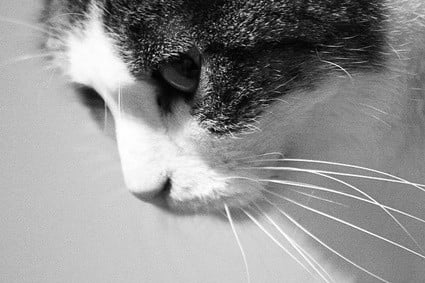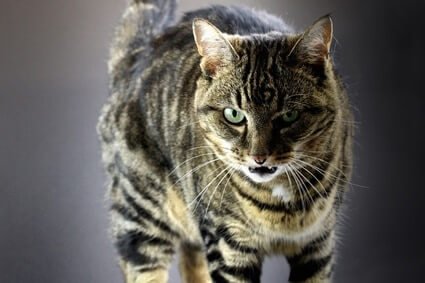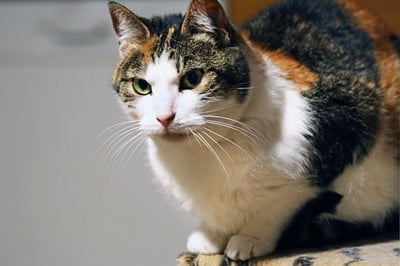Trilling is a high-pitched chirping sound that cats make to greet people or other felines. It’s a welcoming noise that signals when a cat is happy to see someone. Cats also use it as a way to communicate and express themselves.
Trilling is a positive sound that mother cats teach to encourage their kittens to follow them. It’s a high-pitched noise that can be likened to the soft coo of a pigeon. A cat often makes a trill to beckon its owner, say hello to humans and other cats, or request attention.
Trilling is rarely a sign that something is wrong. However, as a cat grows older and becomes needier, the frequency they make this sound may increase. While a trill is a pleasing sound, there is so much meaning behind the noise. Cats are expressive animals, and trilling is one of the ways that they communicate.
What Is Cat Trilling?
Cats make a range of sounds, including meows, purrs, chirps, and hisses. However, trilling is the only sound produced with a closed mouth. Instead of expelling the air, a cat pushes it out through the vocal cords. If humans were to make the same sound, they would need to press air through their flattened lips and blow a raspberry while humming a tune.
The resulting sound is high-pitched and bird-like. It also sounds like a series of Spanish Rs rolling off the tongue. According to the US National Library of Medicine, a trill is produced with a soft voice like the purr.
The sound only lasts a couple of seconds, but a cat might repeat the trill in a short space of time, particularly if it’s feeling happy. It will also increase the frequency if it wants attention.
Cats learn to trill during the suckling and weaning period, where the mother will make a trilling sound to encourage kittens to follow her. In turn, the kittens will learn the noise and mimic it to greet their mother or seek her attention. They will take this into adulthood, and it will become part of their wider communication methods.
Why Does My Cat Trill?
It depends on the cat’s temperament and personality. It’s normally a positive sign and indicates that a cat feels a sense of comfort, ease, and trust around its owner. Here are the most common reasons a cat will produce a trilling sound:
Greeting You
The most common reason a cat will trill is that it’s saying hello. A cat will make the sound as a greeting to people or other cats and express happiness and affection. Because cats only use a meow to communicate with humans, trilling is common in cat-to-cat interactions.
Along with trilling, a cat might rub its head along its owner’s legs or raise its back to encourage its owner to stroke it. As your cat begins to associate trilling with attention-seeking, it may start to become more vocal and use the trilling sound more often.
Wants to Be Followed
To a kitten, a trill means that it needs to follow its mother, who will make the sound to beckon her kittens. As a result, your cat is likely doing the same to you.
Whether your cat wants to be fed or requires attention, a trill is used by some felines as a request for recognition. If this is the case, you might find your cat walks away while maintaining eye contact to encourage you to follow.
Trying to Get Your Attention
Affectionate cats love attention and will trill to get yours. Trilling is a non-threatening, soft, gentle sound. Cats are intelligent animals and understand that to get what they want, emitting a pleasing sound that appeals to our caring, nurturing nature is the most effective way.
This is also why many researchers and scientists compare a cat’s meow to a baby’s cry. A study on Diva Portal supports this, as it describes how cats produce different meows for different purposes.
Communicating with You
Cats are keen communicators and use an array of vocalizations to communicate with humans and other cats. Like the Siamese or Main Coon, some breeds are chattier than others and will vocalize more regularly than quieter breeds.
There are times when you can have a conversation with your cat, too. If you mimic your cat and trill back to them, you can create a stronger bond. You might even begin to understand what their specific sounds mean and can create a unique language with them.

Surprised
If you stroke a sleepy or unsuspecting cat and it replies with a trill, you’ve given your cat a little surprise. A trill is a cat’s way of jumping but in a friendly way. Your cat is also replying to your affection with a greeting.
This shows that your cat is at ease around you and doesn’t mind being woken by you. Some cats become aggressive if woken up, but a trill indicates that your cat is contented.
Do All Cats Trill?
Cats with livelier personalities are more likely to trill, but not all cats do. It all comes down to character. Cats that are naturally shy or aggressive may never trill. Nervous cats who aren’t keen on being around people might not display trilling tendencies either. It’s not unnatural for a cat not to trill.
Cats that were abandoned at birth or grew up with an absent mother are less likely to trill. Without a mother cat to teach the sound, it’s unlikely that a cat will have learned to produce a trill.
This is even more likely in single-cat households. Though, a cat that lives in a home with other felines might pick up trilling from the other animals if they’re prone to making the noise. Motherly cats will display this trait more than cats that are unhappy about new felines entering the household.
Is Trilling a Sign That Something’s Wrong?
In most cases, trilling indicates that your cat is happy and comfortable in your company. Other sounds, like low-pitched meowing or hissing, are indicators that something is wrong. Trilling is reserved for joyous occasions, such as a greeting or affection-seeking exercise.
However, cats sometimes become more attached to their owners as they grow older and begin to need extra care, especially if their sensory perception starts to deteriorate. They might want to spend more time with you and crave attention as their bodies and behaviors begin to change. This is entirely normal, but it’s always wise to keep an eye on any changes in sound or excessive, frequent vocalization.
Underlying issues might be at play, including pain, injury, or illness. While excessive trilling is rarely a sign of something wrong, it’s vital to establish why your cat’s increased trilling in case medical attention is required.
Trilling vs. Purring
Trilling and purring fall under the same category. Both are vocalizations made with the mouth closed and are primarily used as a greeting. Cats also make both sounds to gain recognition, approval, and affection from their owners.
Unlike a purr, a trill is a softer, more high-pitched sound. It always has a friendly meaning, while purring can sometimes signify illness, sadness, injury, or hunger. A journey in Scientific Journal explains that purring can be deciphered from the more stressful moments in a cat’s life. Purring is usually a difficult sound to understand as it hides a plethora of emotions. It’s also difficult to tell whether a purr is a happy or sad sound.
Purring is lower-pitched and generated by the movement of the glottis – the opening between the vocal cords that helps to produce sound.
Cat Trilling in Heat
An unspayed, reproductive cat goes into estrus – more commonly known as heat – multiple times throughout the year. The estrus cycle lasts around a week to 10 days. During this time, a cat will ovulate. A cat in heat will exhibit many observable behaviors and become obsessive about looking for affection from its owners.
The trill is sometimes used as a mating call by female cats in heat. To attract a male partner, she’ll let out a series of trills or trill-meows. Unfortunately, these sweet trills turn into unpleasant yowls as cats become more desperate to attract attention. In turn, an unneutered male cat will respond to these signals by mating with the reproductive female.
Male cats don’t go into heat. Unneutered male cats will instead become aroused at the scent of a female cat in estrus. They will then focus on finding a suitable queen and call for females using a soft trill and a series of meows to attract one.
Because cats are crepuscular animals who are most active at dawn and dusk, you’re most likely to hear an unneutered male cat trilling at night. This is the time that male cats are more likely to meet a female in heat.

Cat Trilling at a Kitten
If you notice a mother cat trilling at her kittens, it is because she is beckoning them to come to her. Kittens will know to respond to this sound and will eventually learn to produce it themselves. They will then take it through to adulthood, where they will use the sound as part of their broader communication methods with humans and other cats.
A mother cat will also trill at her kittens because their sense of hearing is not fully developed. Cats communicate in high-pitched, inaudible sounds, and trilling is a noise that kittens can hear and respond to.
Alternatively, if you bring a new kitten into your household unrelated to an older cat, your cat will trill if it feels friendly towards the new addition. Your cat might use a friendly trilling sound to say hello or beckon it over. Don’t be alarmed by this sound, as it’s a way for both cats to bond. Leave your cats to it but intervene if the sounds suddenly become low and tense. This means trouble is brewing.
Why Does My Cat Trill and Run Away?
This can be a confusing behavior, but your cat wants you to follow where it’s going. You’ll have to figure out what it wants by adhering to its command. Your cat will use body language and behavioral signals to show you why it’s beckoned you. In some cases, the animal requires food, or it might be looking for a tasty treat. A cat may be confused about something that it needs your help with.
Your cat might also want to play. Some cats love to play hide and seek or other fun games and may be in a cheeky mood. If your cat is trilling at you and running away, grab some toys and spend some time teasing your cat. Cats love feather-based toys or laser pens because they are most like their prey. During play, a cat might trill as it jumps to indicate its happiness.
Cat trilling is a sweet and gentle sound that displays the kindest, most affectionate side of its nature. Trilling is lovely to listen to and indicates our cat is happy. The sound is easy to confuse with chirping, which is more commonly used when birds are present, but it’s fairly distinctive. A cat’s trill is often accompanied by head rubbing, which signifies your cat wants attention.

